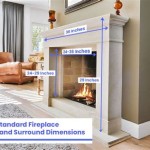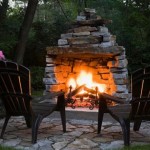Inexpensive Fireplace Inserts: Enhancing Efficiency and Comfort Without Breaking the Bank
Fireplace inserts offer a practical solution for homeowners seeking to improve the heating efficiency of their existing fireplaces. Traditional open-hearth fireplaces often lose a significant amount of heat up the chimney, rendering them inefficient and sometimes even contributing to higher heating bills. Inexpensive fireplace inserts provide a cost-effective alternative, allowing individuals to enjoy the ambiance of a fire while maximizing heat output and minimizing energy waste.
The market for fireplace inserts is diverse, catering to a wide range of budgets and heating needs. While high-end models boast advanced features and premium materials, numerous affordable options deliver substantial improvements over traditional fireplaces without requiring a significant financial investment. These less expensive inserts utilize various fuel sources, including wood, gas, and electricity, each presenting its own set of advantages and disadvantages. Careful consideration of these factors, coupled with an understanding of installation requirements and long-term operational costs, is crucial for selecting the right inexpensive fireplace insert.
Key Point 1: Understanding Different Types of Inexpensive Fireplace Inserts
The term "inexpensive" is relative and depends on individual budget constraints. However, when considering fireplace inserts, the price range typically encompasses models that prioritize functionality and efficiency over elaborate aesthetics or cutting-edge technology. Within this range, three primary types of inserts are commonly found: wood-burning inserts, gas inserts, and electric inserts.
Wood-burning inserts: These inserts offer the traditional charm of a wood-burning fire but with significantly improved efficiency compared to open fireplaces. Inexpensive wood-burning inserts often feature a durable steel or cast-iron construction, along with a sealed firebox and an air intake system designed to optimize combustion. They commonly require a chimney liner for safe and efficient venting of exhaust gases. While the initial cost may be moderate, the ongoing expense of purchasing firewood needs to be factored into the overall cost. Furthermore, wood-burning inserts necessitate regular maintenance, including ash removal and chimney cleaning, to ensure optimal performance and safety.
Gas inserts: Gas fireplace inserts provide a convenient and relatively clean-burning alternative to wood. These inserts typically run on natural gas or propane and offer ease of use with features such as remote control operation and thermostat control. Inexpensive gas inserts often utilize standing pilot ignition systems, which continuously burn a small flame, consuming a minimal amount of gas. While generally more expensive than wood-burning inserts initially, gas inserts eliminate the need for firewood and often require less frequent maintenance. Installation typically involves connecting the insert to an existing gas line, which may require professional assistance and associated costs.
Electric inserts: Electric fireplace inserts represent the most affordable option in terms of initial purchase price. These inserts do not require venting and can be easily installed in existing fireplaces or even freestanding units. Electric inserts produce heat through electric resistance and offer realistic flame effects using LED technology. While electric inserts are convenient and require minimal maintenance, their heating capacity is generally lower than that of wood-burning or gas inserts. Furthermore, the ongoing cost of electricity consumption needs to be considered, as continuous operation can contribute to higher utility bills. Electric inserts are best suited for supplemental heating in smaller rooms or for creating ambiance without substantial heat output.
Key Point 2: Factors Influencing the Cost of Inexpensive Fireplace Inserts
Several factors influence the price of fireplace inserts, even within the "inexpensive" category. These factors directly impact the overall cost of purchasing and installing an insert, and understanding them is crucial for making an informed decision.
Heating Capacity (BTU Rating): The British Thermal Unit (BTU) rating indicates the heating capacity of an insert. Inserts with higher BTU ratings are capable of heating larger spaces but typically come with a higher price tag. When selecting an inexpensive insert, it is essential to determine the appropriate BTU rating for the size of the room intended to be heated. Choosing an insert with excessive heating capacity can lead to unnecessary energy consumption and potentially higher operating costs.
Materials and Construction: The materials used in the construction of a fireplace insert significantly impact its price and durability. Inserts constructed from heavy-duty steel or cast iron are generally more expensive than those made from lighter materials. Similarly, features such as double-walled construction and ceramic glass doors can add to the cost. While inexpensive inserts may utilize less expensive materials, it is important to ensure that the construction is robust enough to withstand regular use and provide adequate safety.
Features and Functionality: The availability of features such as thermostats, remote controls, blowers, and variable flame settings can influence the price of a fireplace insert. Inexpensive inserts may offer fewer features compared to high-end models. However, focusing on essential features that align with individual heating needs can help minimize costs without sacrificing functionality. For example, a blower can significantly improve heat distribution, while a thermostat can automate temperature control and potentially reduce energy consumption.
Installation Costs: Installation costs can represent a significant portion of the overall expense of installing a fireplace insert. Wood-burning and gas inserts typically require professional installation to ensure proper venting and safe operation. Electric inserts are generally easier to install but may still require electrical work to ensure adequate power supply. Obtaining quotes from multiple installers and factoring in the cost of permits and materials is crucial for accurately estimating the total cost of the project.
Key Point 3: Evaluating Long-Term Operational Costs
While the initial purchase price of an inexpensive fireplace insert is a primary consideration, it is equally important to evaluate the long-term operational costs associated with each type of insert. These costs include fuel consumption, maintenance, and potential repairs, and they can significantly impact the overall cost-effectiveness of the investment.
Fuel Costs: The cost of fuel represents a significant ongoing expense for wood-burning and gas fireplace inserts. The price of firewood varies depending on location and availability. Similarly, natural gas and propane prices fluctuate based on market conditions. Electric inserts, while eliminating the need for traditional fuels, contribute to electricity consumption and higher utility bills. Carefully estimating fuel consumption and comparing the costs of different fuel options is essential for making an informed decision.
Maintenance Costs: All fireplace inserts require regular maintenance to ensure optimal performance and safety. Wood-burning inserts necessitate frequent ash removal and annual chimney cleaning. Gas inserts require periodic inspections and cleaning of the burner and vents. Electric inserts require minimal maintenance, primarily consisting of cleaning the glass and checking the electrical connections. Factoring in the cost of maintenance supplies and professional services is crucial for accurately assessing the long-term operational costs.
Repair Costs: Like any mechanical appliance, fireplace inserts are susceptible to wear and tear and may require repairs over time. The cost of repairs can vary depending on the type of insert, the extent of the damage, and the availability of replacement parts. Selecting an insert from a reputable manufacturer with a solid warranty can provide peace of mind and potentially reduce the risk of unexpected repair costs. Regularly maintaining the insert according to the manufacturer's recommendations can also help prolong its lifespan and minimize the need for repairs.

9 Best Electric Fireplace Inserts Of 2024 Tested And Reviewed

Gas Fireplace Insert Cost Forbes Home

Wood Burning Fireplace Inserts Insert Installation

Wood Inserts We Love Fire

Fireplace Inserts Make Fireplaces More Attractive And Efficient Woodstoves Patio

Century Heating Cw2100 Wood Burning Insert Rockford Chimney

Fireplace Inserts Butler Pa Martin S And Service

Electric Fireplace Inserts Fireplaces Direct

Fireplace Insert Stoves Wood Gas Pellet Traditional Baltimore Maryland

Efficient Fireplace Inserts Upgrade Your Home Heating I Napoleon Fireplaces








